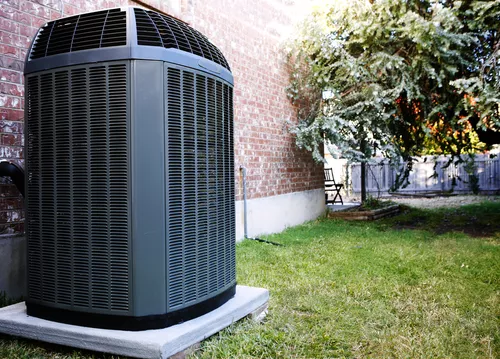By taking sensible precautions, you can keep the exterior unit of your air conditioner in good working order and safety throughout the year, not only when it rains. In this article, we’ll discuss your concerns and offer real-world advice for protecting your air conditioner from damage, even in the face of heavy downpours.
HVAC design:
The heat pump technology used by your air conditioner transfers heat from inside to outside. One part of the air conditioner, the evaporator coil and blower, is installed indoors, while the other, the compressor and condenser, are placed outdoors. The outside component must be robust since it is constantly subjected to harsh weather.
Copper, aluminium, and plastics are used because they are strong and resistant to corrosion, and electrical components are sealed from the weather. Despite your best efforts, your HVAC system is still at risk from things like flying branches, flying debris, flooding rains, and salty air. Costly repairs can be avoided and energy efficiency can be increased with regular maintenance that includes a thorough cleaning.
Should I cover my outdoor AC unit?
Even though you might think of covering your outside air conditioner before a storm, you never should. Never fear the heavy snowfall — outdoor gear is designed to survive the elements.
Just like any other outdoor appliance, your air conditioner needs ventilation holes to prevent mold and mildew from forming. Plus, coverings might contribute to or exacerbate a variety of other issues. In colder months, animals, especially rats, will seek shelter under the cover.
Lack of airflow through the lid will cause condensation to form within. Mold growth is encouraged by this, and you don’t want mold spores floating throughout your home. Because of the increased humidity, it can also lead to corrosion in the air conditioner’s internal components.
-
Flooding:
When floods are an issue, the risks become much higher. During a severe storm, if your air conditioner is even partially submerged in water, it will be severely damaged. Flood damage can be avoided most effectively when the unit is being installed. Your item should have been set up on a base, as recommended by the expert. If that doesn’t work, you can try protecting the unit from flooding by building a wall around it.
In the event of a more severe storm, such as a hurricane or snowstorm, falling tree branches are more likely to cause damage to your apartment than floods, provided that you do not live in a flood zone. Immediately following the end of the storm, you should go outdoors and look for any potential damage caused by falling trees or other large pieces of debris.
How to take precautions against flood and other hazards?
Your outdoor air conditioner is at risk if water pools around it. What should you do if you don’t want to cover your outdoor air conditioner during the rainy season to keep water and debris out? Maintaining your home and the property around the outside unit is your best bet.
-
Install a leaf guard system:
To guarantee that your gutters do their job, you need first install a leaf guard system and keep it in good working order. Many air conditioners are positioned in or near the gutter. If the gutters become clogged, water will overflow and perhaps land on the air conditioner. That raises the possibility that dust and other particles will get sucked into the system, wreaking havoc on the fan and motor.
-
Prune any plants:
Next, prune any plants near the air conditioner, such as bushes, flowers, or trees. Any vegetation within two feet of the air conditioner should be eliminated. That lessens the possibility of damaging the air conditioner from flying debris during heavy rainstorms.
-
Make sure water is draining:
When it rains, ensure water doesn’t collect around the air conditioner, as this could lead to costly repairs. The unit should be fine in moderate amounts of standing water, but it could be severely damaged by more severe flood conditions. Check the area again after storms to make sure water is draining away from the unit.
-
Keep all clutter away:
Finally, keep all clutter, including garbage cans, patio furniture, and other stuff, away from your outdoor air conditioner. If you aren’t there to detect and remove them once the rain stops, these materials can get blown inside the unit and clog the vents. The likelihood of an AC unit being damaged increases in proportion to the amount of flying debris on the property.
When it rains, are window air conditioners safe to use?
Window air conditioners installed are as weather-resistant as those installed indoors. Since these smaller units are less likely to be serviced by a professional, there are several unique factors to keep in mind.
When installing a window unit, it’s important to take precautions to prevent water from leaking in and damaging your home’s interior. Even if you plan to remove your window air conditioner during the cooler months, taking the effort to verify that it is sealed properly is still worthwhile. Humidity can be reduced by window air conditioners if they are properly insulated.
Does bad weather prevent HVAC service?
Technicians rarely perform maintenance on outdoor units while it is raining. The item could be damaged by moisture, and working on electrical components in the rain is obviously dangerous. The situation becomes considerably more hazardous if the unit is located on the roof.
Lightning and strong winds are possible, and the rain will make things slippery. Technicians cannot safely service an outdoor unit if the weather is poor. If your unit is located on the roof, the technician may need to wait for the weather to clear before fixing it.

